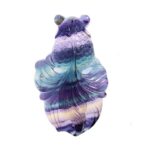Crystals, with their captivating beauty and purported therapeutic properties, have gained immense popularity in recent years. Accurate identification of crystals is crucial to fully appreciate their qualities and ensure the authenticity of your collection. This comprehensive guide empowers you with the knowledge and techniques to confidently identify a wide range of crystals.

Physical Properties
Color
Crystal color is a primary identifying characteristic. Different minerals and chemical compositions produce distinct hues, such as:
- Clear: Quartz, calcite
- Green: Emerald, malachite
- Blue: Sapphire, turquoise
- Red: Ruby, garnet
Shape and Structure
Crystal shape is determined by its internal atomic arrangement. Common crystal systems include:
- Cubic: Garnet, pyrite
- Hexagonal: Quartz, calcite
- Tetragonal: Zircon, rutile
Hardness
The hardness of a crystal indicates its resistance to scratching. The Mohs scale measures hardness from 1 (softest) to 10 (hardest). Examples include:
- 1: Talc
- 5: Fluorite
- 7: Quartz
- 10: Diamond
Cleavage and Fracture
Cleavage describes how a crystal breaks along specific planes defined by its internal structure. Fracture refers to irregular breaks. Types of cleavage include:
- Cubic: Breaks into three perpendicular planes
- Hexagonal: Breaks into six rhombohedral shapes
Optical Properties
Luster
Luster describes how light interacts with a crystal’s surface:
- Metallic: Shiny, like metal
- Vitreous: Glassy
- Adamantine: Extremely brilliant, like diamond
Transparency
Transparency refers to the ability of light to pass through a crystal:
- Transparent: Light passes through easily
- Translucent: Light passes through but is diffused
- Opaque: Light cannot pass through
Other Properties
Density
Density is the mass of a crystal per unit volume. It can help identify minerals with similar appearance but different densities.
Magnetism
Certain crystals, such as magnetite, exhibit magnetic properties. This can be used to differentiate them from non-magnetic crystals.
Identification Techniques
Visual Examination
Careful visual examination can provide valuable clues to crystal identification. Consider the crystal’s color, shape, and luster. Use a magnifying glass to observe fine details.
Hardness Testing
Use a Mohs hardness kit to determine the hardness of a crystal. Scratch the crystal with different minerals of known hardness until you find one that produces a noticeable scratch.
Optical Characterization
Examine the crystal’s transparency and luster under different lighting conditions. Use a polarizing filter to observe interference colors, which can provide further insight into its optical properties.
Chemical Testing
Specialized chemical tests, such as flame tests or wet chemical analysis, can identify specific elements or chemical compositions. However, these tests should be performed by experienced professionals.
Table 1: Common Crystal Colors and Corresponding Minerals
| Color | Minerals |
|---|---|
| Clear | Quartz, calcite |
| Green | Emerald, malachite |
| Blue | Sapphire, turquoise |
| Red | Ruby, garnet |
| Yellow | Citrine, topaz |
Table 2: Crystal Systems and Common Minerals
| Crystal System | Minerals |
|---|---|
| Cubic | Garnet, pyrite |
| Hexagonal | Quartz, calcite |
| Tetragonal | Zircon, rutile |
| Trigonal | Tourmaline, hematite |
Table 3: Hardness of Common Crystals on the Mohs Scale
| Mineral | Hardness |
|---|---|
| Talc | 1 |
| Gypsum | 2 |
| Calcite | 3 |
| Fluorite | 5 |
| Quartz | 7 |
| Topaz | 8 |
| Corundum | 9 |
| Diamond | 10 |
Table 4: Magnetic Properties of Crystals
| Mineral | Magnetic |
|---|---|
| Magnetite | Yes |
| Hematite | Weakly |
| Pyrite | Non-magnetic |
| Quartz | Non-magnetic |
Future Applications
As our understanding of crystals continues to deepen, innovative applications emerge. One potential area is “crystaltronics,” which explores the use of crystals to create novel electronic devices with enhanced properties.
Conclusion
Identifying crystals accurately requires careful observation, testing, and knowledge of their physical and optical properties. By mastering the techniques outlined in this guide, you can confidently determine the type and authenticity of your crystal collection. Embark on this captivating journey into the world of crystals, unlocking their beauty, properties, and potential for countless applications.




























